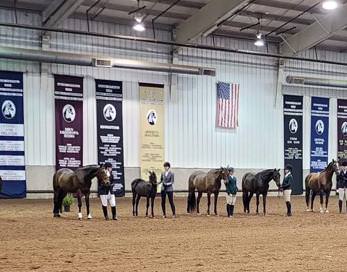I read the nutrition stuff coming out, then look at the horses who " got the best of everything" from in utero, to working ages, and see them with problems. Often little things, nagging away, while other horses have more serious issues develop, seem to need a lot of Vet attention to be used as they age. Both these type horses often retire at younger ages, unable to perform at their “potential” ever.
Yes there are obviously horses that do well, perform quite well, stay pretty sound over the years.
And then we look back to see horses of unknown lineage, raised without the extras, maybe pasture and hay only as young colts. Sometimes kept in horrifying locations full of hazards, machinery, that come out unscarred, sounder than the dollar! And they outperform better bred horses, stay sound into their 20s or later. The famous Appaloosa School Horses many of us learned to ride on, seemed to be a breed apart in being level-headed, amateur friendly, easy keepers, long lasting in constant work.
They never seemed to suffer the ills of present well-bred young horses. OCD was unknown, along with many other things we now check for. They had big feet, thick-walled hooves, proportionate to their body size. Hay quality was often questionable. “I have been haying those fields for years. No fertilizer except spreading manure on them. Fertilizer is expensive you know!” was what I heard buying hay way back in the day. But the horses ate it just fine, not wasted, and they grew well on it. No “horse vitamins” even being marketed! Just the old voodoo things available for shiny hair. Ha ha
Any breeder raising nice stock, investing in providing very nice youngsters MUST be turning some profit to stay in business. Those who talk of “bargin horses” they lucked into, may not be able to buy a second one since breeder had to get out of the business. Horses were sucking away all their money. No buyers to pay back what breeders have invested to produce the great young horse. No one can run a business that doesn’t turn a profit!
We breed (though not often) from good stock. Mares have been good performers for us. Then raise them the old-fashioned way. No fat mares or young horses here! Been around long enough to see the downside of overfed mares and young horses. Ours grow at their own speed over time, which can stretch out when fed hay, pasture, a TRUE handful of grain with daily vitamins once a day. But also no body issues, legs and hooves totally sound. No mature looking 3-4-5 year olds here, still leggy. Not done growing yet. But we raise ours to last for the long-term, 18 years or more in competition.
We breed for ourselves, will only sell a horse who doesn’t work in our program. It takes a YEAR or more to move that horse. It has all the requested items, well behaved, loads, unloads quietly, easy to handle, good to tack up, ties well, get trims or shoes, friendly to catch, easy to ride. New owner can then polish horse for their desired discipline, dressage, hunter, jumper, trail riding, driving. Yet like the Trail Horse Thread, no one wants to pay for a horse with those skills! And being in Michigan, not many people are willing to travel to look at them. Our horses are sound, stay sound into their 20s, even with lots of use, many miles under their hooves.
I am not giving them away. No, I may not make back every penny I have into them, but they are worth the price you pay. I would not be a breeder for anything. Way too much grief moving your young horses on. Seen it over and over.
So funny but also sad, reading of people who buy and pay big money for a horse with the ability to perform and owner is afraid of it! Everyone else rides the horse, says good things, but owner can’t manage it. Owner has the dream, but can’t ride well enough or be in charge of their horse. Sad for the horse who doesn’t “get it” when he goes like he was bred to do! Read the threads, people over-horsed, afraid, or owning horses needing constant medicating , body care, expensive custom tack, to “maybe” be usable. Not the way owning horses should be.
There SHOULD BE some fun in having a horse and using it!
So was it nature or nurture that made them that way?


 What she said. lol
What she said. lol
